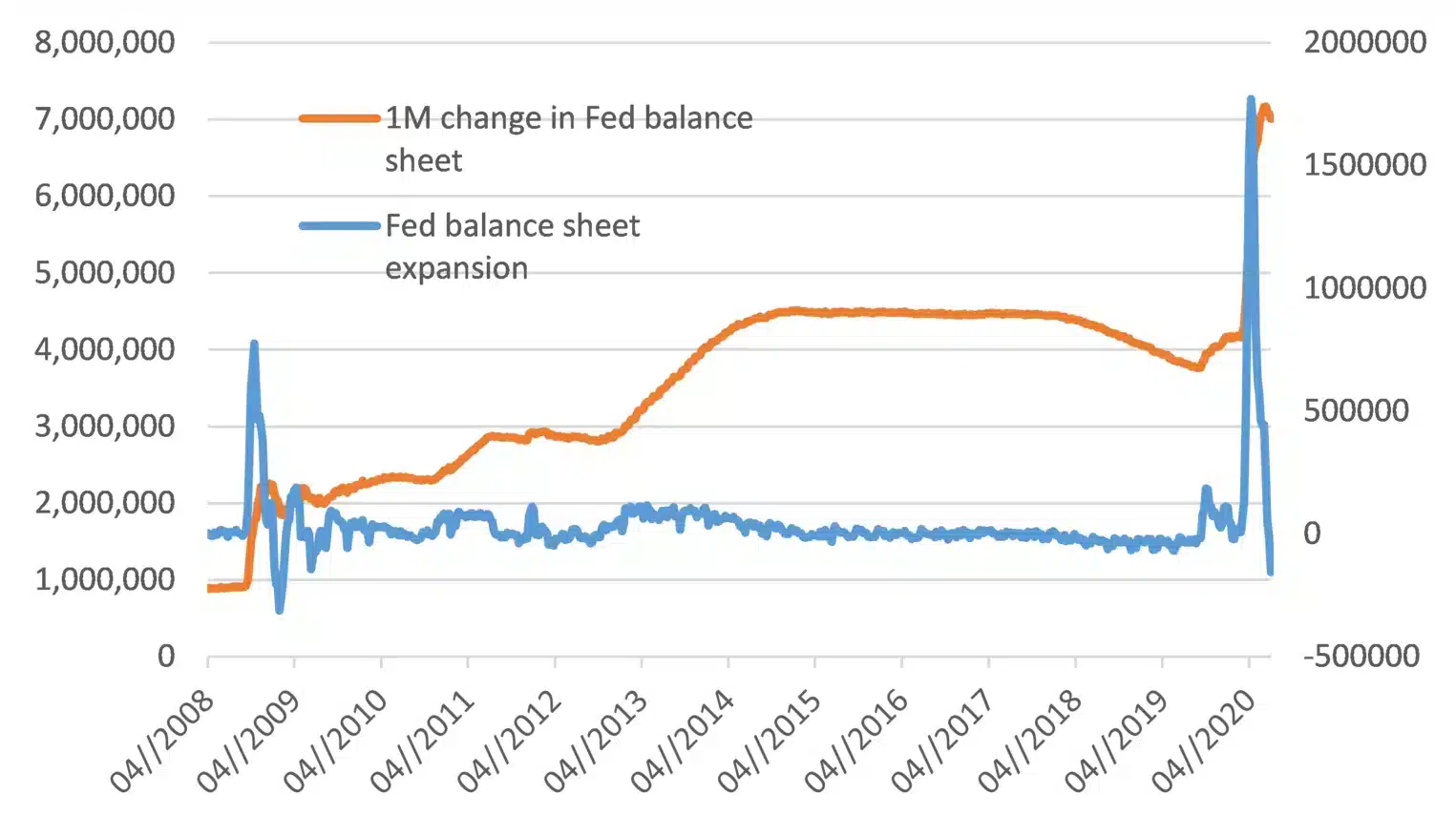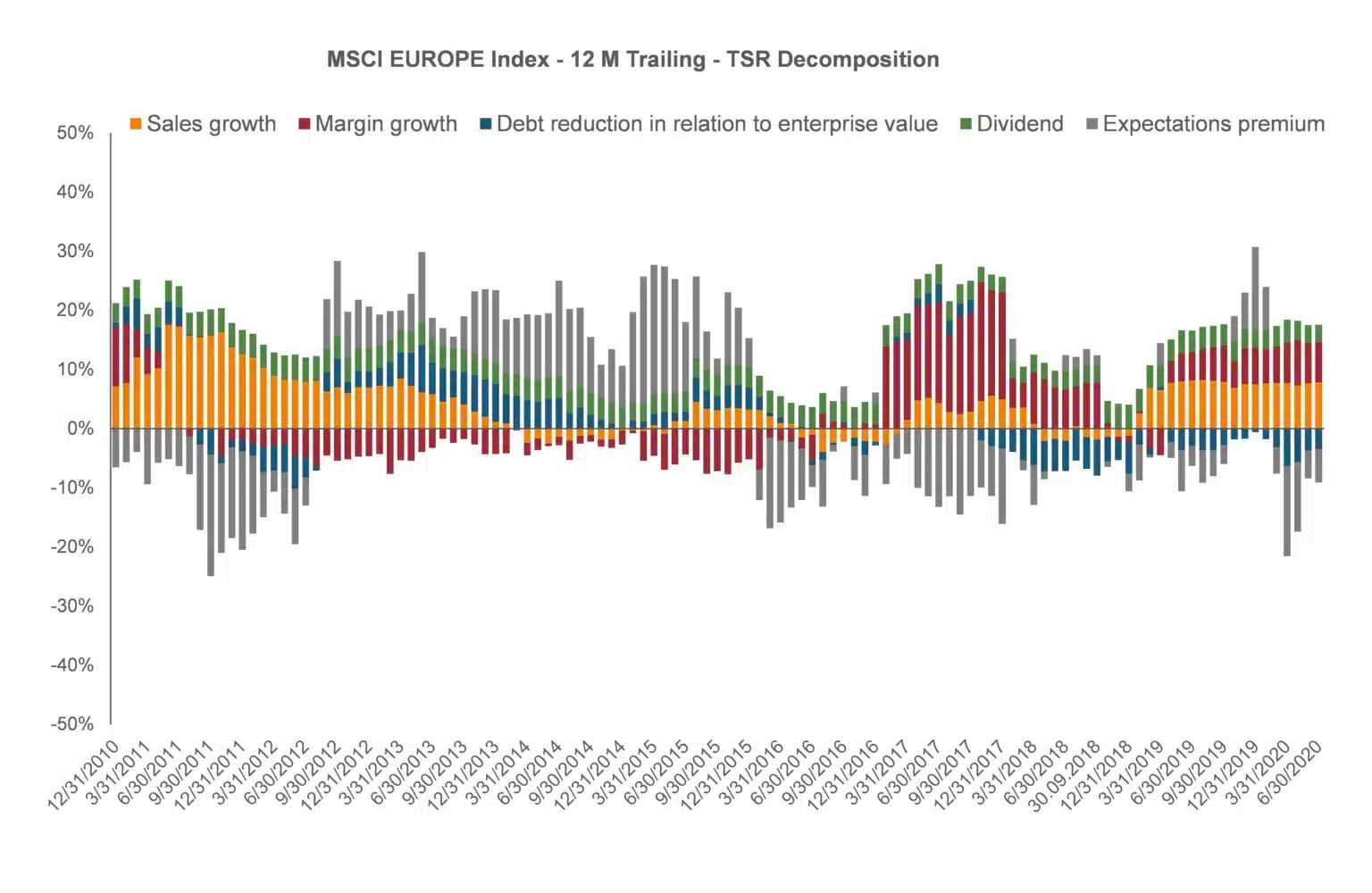COVID as an opportunity for growth quality stocks
The skies were clear for the stock markets as we entered 2020: unemployment was low and economy was unexpectedly calm with both inflation and interest rates low, creating support for continued growth. But after a 10-year bull run, the worries were mounting that a stock market bubble could be forming, helped by historically low bond yields. However, possibly no one expected that the ultimate sell-off trigger would be a global disease outbreak, which literally paralyzed a number of economic sectors, sending equity indices into the freefall. Volatility was back to the levels not seen since 07/08, but this time we witnessed huge amount of liquidity being pumped in the economy by Central Banks (USA spent 11% of GDP on different fiscal stimulus measures, EU – over 5% of GDP, China – 4% of GDP), providing much-needed support for equities; therefore, the panic was curtailed relatively quickly.
The initial panic was replaced by certain degree of rationality as investors came back to their senses, and clear winners benefitting from the paradigm shift in the economy began to crystalize. Among the best performing sectors, helped by stay-at-home situation, was Consumer Discretionary, driven by the surge in online retail (Amazon, Wayfair, HelloFresh) and increased interest in home improvement (Home Depot, Lowe’s). The Information Technology, together with Communication Services, performed relatively well too, supported by massive increase in number of people working from home (Microsoft, TeamViewer) and spiking demand for digital entertainment (Facebook, Netflix, Activision Blizzard, Evolution Gaming). Abovementioned sectors and representative examples are vivid constituents of the growth indices, which once again have beaten value stocks, e.g. returning 12% in USA since the beginning of 2020. For the general market, the resulting return was also not too bad (world stocks declined by 5.5%), despite drastic GDP slides and huge uncertainty regarding future economic development.
Monetary policy once again proved itself to be a super-powerful tool for driving stock markets, which worked perfectly also last year. However, will money-printing practices be able to stimulate economies at the same pace as they did with equity markets and will potential equity bubble created by huge liquidity be justified by fundamental improvement?
Regardless of how things develop on the stock market, we are strong believers in Quality stocks, which have resilient business models as proved by their outperformance in all markets in 1H 2020. They are well-prepared for the ‘new normal’ economy and should rather benefit from the new setting, therefore having justified valuation levels. So, the statements of extremely overvalued stocks, we see here and there, could be ignored in this case.
Portfolio Buy, Sell and Hold Decisions in 1H 2020
See below few of investment decisions we have taken with regard to Quality portfolios in the first half of 2020.
Homeserve (BUY)
Just before 2020 started, we expanded our European portfolio by adding a rather boring company, which, however, is distinguished by sustainable recurring revenues. It is always nice to have a company with a subscription-based business model in the portfolio. And this time it was HomeServe, which offers homeowners a protection against expenses and inconvenience caused by water, sewer, electrical, heating, etc. emergencies.
Relying on a network of employed and subcontracted tradespeople, the company offers subscription-based home assistance for plumbing, heating and electrical malfunctions. In UK (40% of sales), its home market, ‘membership‘ market is mature and the company is boosting profits by ditching customers that dip in and out of policies based on discounts, while selling more comprehensive cover to loyal policyholders. In North America, where long-term growth prospects look more compelling, market penetration is at same 30% as in UK, but the market size is much larger – it can be estimated that around 40m out of the 135m homes might purchase such assistance services. Currently, US business (34% of sales) is growing by ~15-20% y/y.
The Home Assistance market in regions where HomeServe operates is estimated to be worth £14bn, but this is dwarfed by the £450bn ‘home experts’ market that the company is now moving into and is about to make its next growth pillar. The role of ‘Home experts’ websites is to match vetted and reviewed tradespeople with customers, with revenue generated by charging tradespeople a monthly fee to access a directory of potential jobs. The market is immature if compared with areas such as holiday booking and property search (e.g. Airbnb), but, as illustrated by the likes of Rightmove and AutoTrader, there is a potential to create huge value from provision of go-to destination to find tradespeople. Although it does not contribute to group profits at present, the long-term potential of HomeServe’s disruptive Home Experts model could be very large indeed. The addressable market could, according to HomeServe, be 30x the size of Home Assistance market. Recurring revenues and promising growth segments boast all the characteristics we look for in a high-quality growth business.
Company’s resilient business model proved itself also during lockdown period as HomeServe did not see a noticeable increase in cancellations and continued to deliver solid financial performance. In May it reported a 12% rise in adjusted pre-tax profit for the year ended March 31 and, unlike thousands of companies that have scrapped or slashed their dividends to conserve cash, HomeServe even lifted its payout by 10% (1.8% dividend yield). Homeserve, having utility-like business model with growth-tilt, returned 1.1% in portfolio ,outperforming the market by 13.0%.
Booking (SELL)
We really wish to think that if it wasn’t for global havoc brought upon each and every one of us by COVID-19, our hopes for the recovery of Booking.com would have been fulfilled (see our Annual Review 2019). Our bet on the unmatched scale of the company, client access and cash generation ability seemed very solid at that time. Unfortunately, life tends to intervene and make own corrections, which it did through pandemic outbreak, global lock-downs and suspension of travel as a final blow.
The repercussions of closing the borders for the whole travel industry were rather clear to us. What we underestimated was the length of the lock-downs and psychological effects those would have on people and their attitude towards moving around. Booking.com comments that it would take two to three years for passenger volumes globally to reach 2019 levels appeared to be rather unnerving and sobering at the same time. Also, as customers were forced to change their habits during pandemic, like keeping in touch with the help of virtual meetings and it stick, business travel will likely be hit by this structural trend of companies migrating to Zoom, hence reducing the necessity to travel even when global borders open up again.
Those new developments made us, reluctantly to be completely honest, to reconsider our investment case and face the reality check. We remained strong believers in company’s ability to emerge victorious when things finally come back to normal, but the fact that it will take several years rather than months to do so, made us consciously pull the plug. As sectors most affected by pandemic, travel including, saw a sharp recovery on the stock markets in May, we saw it as a good opportunity to part with Booking.com despite still quite a significant underperformance of slightly over 40% versus S&P 500.
“Mistakes were made” is probably one of the hardest things one can ever come out with. Missteps do happen and while often painful, they all bear important lessons that we need to learn and move on enriched with new knowledge. Like the one we were taught with Booking – regardless of how much faith you have in a business model and personal fancy toward a particular company, external circumstances will eventually catch up and cost you your money. And if you managed to cut a finger before losing the entire hand, you can consider yourself a lucky one.
ZTO Express (BUY)
During 1H 2020 same patterns were observed all over the world: face-to-face meetings were replaced by Zoom-meetings, eating outside and shopping in malls – by home deliveries. Demand for e-commerce and delivery services spiked during the outbreak, and if earlier a courier for JD.com in Beijing would deliver about 140 to 150 packages per apartment complex a day, his daily order book easily surpassed 200 mark during lock-down.
This e-commerce mega-trend helped us to enjoy a solid return on recent investment, a Chinese express delivery company that we added to our portfolio in February 2020. ZTO Express, covering over 98.6% of China’s cities and counties, is a leader in China and one of the largest express delivery companies globally. Supported by Alibaba’s investment (10% ownership), ZTO Express represents one of the main providers for millions of online merchants and consumers, transacting on leading Chinese e-commerce platforms, such as Alibaba and JD.com. Moreover, company intends to continue to explore and leverage other international expansion initiatives in the future.
Over the years, ZTO Express has recorded consecutive annual increases in market share (7.6 % market share in 2011 vs 18.6% market share in 2019). This is a somewhat expected result, given that the company has excellent regional coverage, strong asset base of self-owned line haul fleet, a high degree of automation, and centralized route optimization. Those characteristics have enabled ZTO to achieve strong operational efficiency and significant cost savings, which turned it into one of the industry’s cost leaders and helped in navigating perilous waters at times when the average selling price (ASP) tended to decline.
Since in portfolio, ZTO Express yielded 52.09% and outperformed MSCI EM by 61.27%. Despite intense competition in the industry that puts additional pressure on ASP we expect sound earnings growth for the company, which is supported by leading market share, robust balance sheet, promising Capex plans (adding higher capacity trucks and launching unmanned sorting centers), efficient cost planning and top-notch service quality.
Outlook: Central Banks in full support, pandemic effect, adaptation and digital transformation
1. Nothing stops Central Banks from pumping more money
What was seen last year, accelerated this year: Central banks’ efforts to revitalize economic growth provided a great support to the equity markets in 2019 and continue to do so also this year as Central banks entered ‘stimulating mode’ to prevent economic disaster caused by pandemic across the globe. The unemployment rate in US jumped from 3.5% before disease outbreak in December 2019 to 14.7% in April 2020 – highest level since depression time, lockdowns caused GDP to decline – all that has forced FRS to unprecedentedly expand its balance sheet and to lower the key rate to 0% for first time since the Great Recession.
Fig.1 FRS expands balance sheet to support economy

Source: Hérens Quality AM
Similar CBs behaviour is seen everywhere, thus stimulation of the US economy is not expected to fade until COVID-19 is tamed and return to normal or “the new normal” operations happen, with full employment level pushing its way forward. This provides a good ground for the stock market to continue with bullish mood. That, however, could lead to a concern around stock valuations and if those are fundamentally justified. But we are sure that quality stocks with proved revenue streams will benefit in any scenario of stock market development.
2.Higher corporate indebtedness – new normal?
Deleveraging motivated by the GFC did not last for long – corporates started to expand their debt burden again being greatly encouraged by low interest rates (see TSR charts). Debt loading was accelerated by the pandemic situation as firms, particularly those operating in sectors facing the strongest headwinds, needed cash to support their operations. Some firms expanded debt portion in capital structure to chase faster growth, using unfolding situation to transform themselves by growing e-commerce and other online operations.
Fig.2 Total Shareholder Return Decomposition, MSCI Europe, MSCI USA

Source: Hérens Quality AM
Most probably we would need to get used to the higher debt levels, but it should be rather welcomed in case of a quality company, which has a distinctive competitiveness, growing KPIs and plausible development strategy led by talented management.
3.Pandemic accelerates transformation of industries
Remote working, less shopping and dining out, commuting by bicycle, video-conferencing instead of business travel – coronavirus is changing our habits, and businesses are forced to adapt. Retailers are developing e-commerce operations at full speed now, simultaneously closing their physical shops (e.g. Microsoft, Victoria’s Secret, Walgreens). Events and conferences as well as communication within many organizations are transferring from offline to online mode, providing an excellent tailwind for such services as Zoom and Slack. Pandemic spread and border closure make companies think more local, trying to ensure home production that is run without disruptions. For instance, TSMC, the leading contract chipmaker based in Taiwan, has agreed to build plants in the US in a response to the growing concerns on behalf of US administration regarding the security of global supply chain, while an auto parts manufacturer supplying Mazda shifted some of its production from China to Mexico, where car manufacturer produces for local and US markets. So, coronavirus was a trigger for the companies to be more aware of the operational processes and for the consumers to adapt their behavior, which could all lead to more sustainable lifestyle becoming a perfect driver of ESG thinking.
